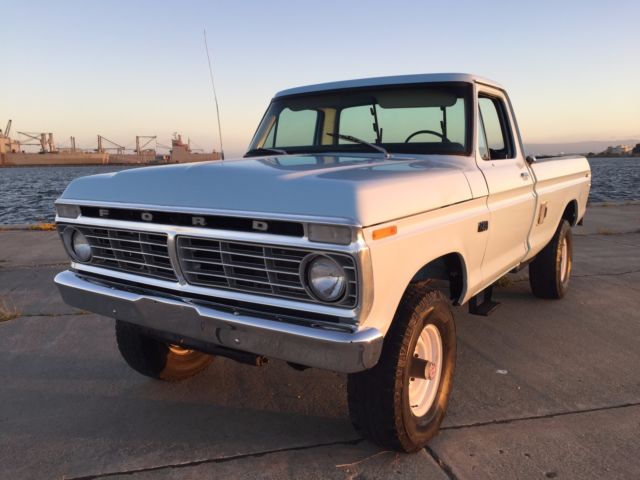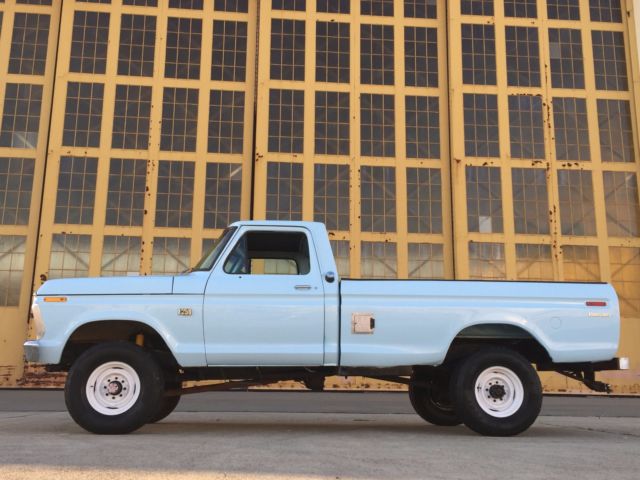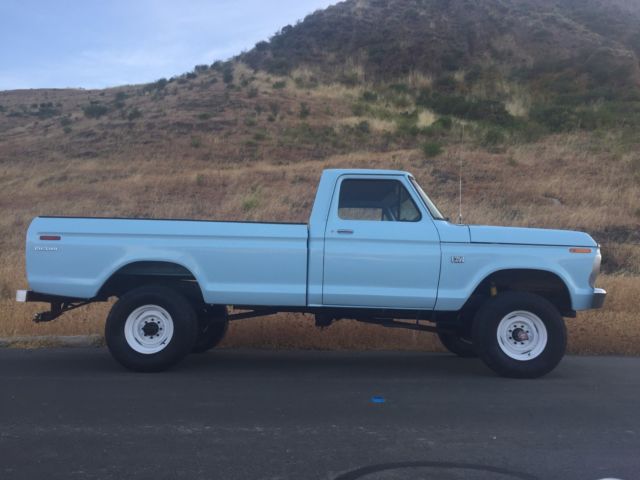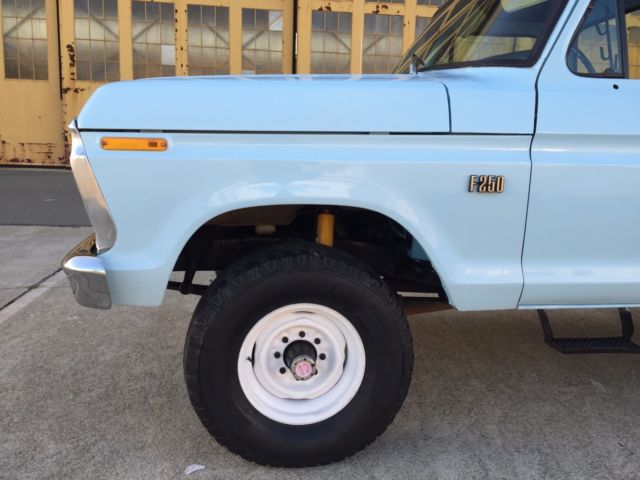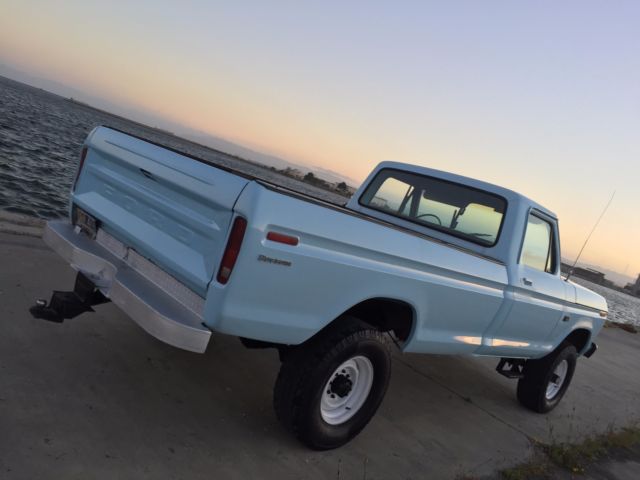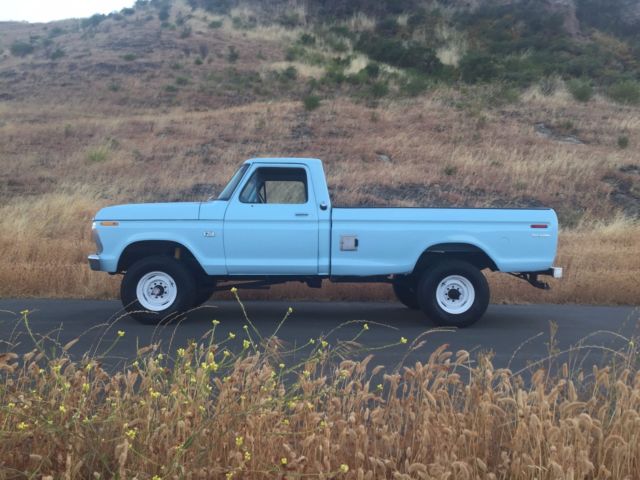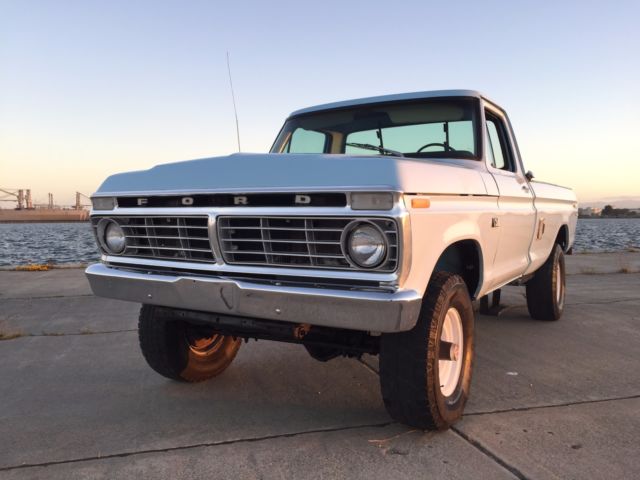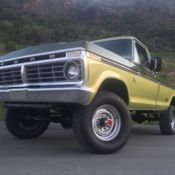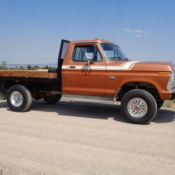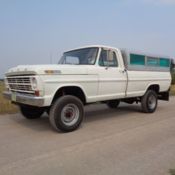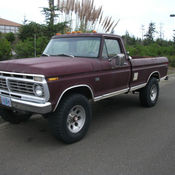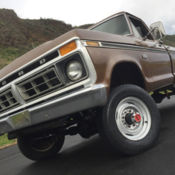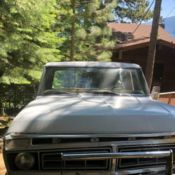1973 Ford F250 4x4 HighBoy Barn Find First Year "Dentside" Body Style No Reserve
| Make: | Ford |
| Model: | F-250 |
| Type: | Standard Cab Pickup |
| Trim: | Custom |
| Year: | 1973 |
| Mileage: | 67,043 |
| VIN: | F26YRR51027 |
| Color: | Blue |
| Engine: | 429 |
| Cylinders: | 8 |
| Fuel: | Gasoline |
| Transmission: | Manual |
| Drive type: | 4WD |
| Interior color: | Black |
| Vehicle Title: | Clear |
| Item location: | Oakland, California, United States |
| Extras |
|
Air Conditioning 4-Wheel Drive, Cassette Player |
| Listed by | Private seller |
Description of 1973 Ford F-250 Custom |
1973 FORD F250 4x4 HighBoyNO RESERVE
Up for bid is a rare find and a unique opportunity to buy a first year body style 1973 Ford F250 “Highboy” 4 wheel drive pickup. This vehicle would be nearly impossible to duplicate and is truly a one of a kind that is being offered on a NO RESERVE auction and will sell to the last bidder. This 44 year old survivor that has been locked away in a time warp as it has been in storage for over 20 years. The original owner stopped driving in the mid 1990’s and the truck was unused for the last two decades. This is a very rare optioned classic and the first year for what collectors call a “Dentside” which was ordered with factory air conditioning in light blue exterior with black interior. This truck would be very difficult to duplicate. This vintage 4x4 was built in San Jose California over 4 decades ago and was liquidatedfrom an estate of the original owner and who is long gone. It was acquired from his now elderly daughter who explained he used it primarily for hauling wood and hunting in and around the Rouge River area of Oregon. The bed has been used and has some dents but has a Ford bed liner that was fitted many years ago. The owner was a mountain man who was most likely a product of the great depression and felt why buy something if you can make it yourself especially when time is not a factor. He built his own custom drop hitch with many hours of engineering on an item you could buy at Walmart for around 40 bucks. He also custom built his own steps that were left as a tribute to this unique owner and truck. The factory air is complete but is in/op and it looks like he converted the compressor to an on-board air compressor which is something I have never seen. He also over engineered a custom auxillary battery tray in the engine compartment. The last year of registration of this truck expired in 1998 but has been stored since at least 1997. The Highboys are very significant as the most desirable factory 4x4 of its era with it’s stout frame, increased height compared to other light-duty pickup trucks, and divorced transfer case. Chrysler and GM did not have a counterpart. Cosmetically this truck looks fantastic. The body is very clean. The door panels are original and have sever cracks and have been reattached to the door. Seat is in good shape. Dash is quite nice for the age. Headliner is new. The interior is very nice with an original dash cover that still looks new, it also has the original vinyl floor mat and original hard plastic door panels that are worn and cracked. The truck has factory air vents which was very rare in 1973 so rare that Ford farmed out to a company in fort Worth Texas.Mechanically at some point when the original owner was still driving the original 360 V8 was replaced with a Lincoln/Mercury 7 litre 429 V8. It has the original heavy duty NP-435 4 speed manual with granny low and a 8-lug full floating Dana 60 with 16 splines and a 4.10 axle ratio. It is set up for PTO. The trucks original fuel system has been replaced starting with a brand new (never had gas in it) NOS original in cab fuel tank. We were lucky to find this out of production item. All of the fuel lines were replaced and a new fuel pump and new Holley carburetor was installed along with new starter. The truck also has new plugs, new wires, new cap, new rotor, and all fluids were flushed and replaced with fresh oil and fresh coolant before we were able to fire it up to see if it runs which it does. It does have an exhaust leak on the passenger side exhaust manifold but it is a runner. It will need new exhaust manifolds and some more attention as it has been sitting for over 20 years. It does have a non/operational second optional fuel tank that could be cleaned and made functional. As we mentioned it has the type of fuel tank that it left the factory with inside the cab and is possibly the only “Dent Side” with a new operational in cab tank as they are no longer available. The odometer appears to be in/operable. Most likely a cable. All of this effort for this super rare barn find was done to see if it ran; the motor does run but has a misfire it will for sure need a new exhaust manifold, the clutch seems to be in good shape as it shifts through all the gears including the transfer case which shifts in and out of 2wd and 4wd, low and high range. The brakes were completely replaced as a result of lack of use. It has all new brake drums, wheel cylinders, oil seals, etc, It will need a new power booster but everything else is new. The original wheels on this era of HighBoy were 16.5 and are very difficult to get tires for. The original tires were dried and cracked so the wheels were updated to 16/7 Ford steel wheels from a 2007 Ford E350. The tire size is 285/75/16. Fords calendar year production of gas powered trucks in 1973 totaled 920,873 units, of which 187,348 were F250 4x2. Very few 4x4 were made and and in fact so few that Ford has no records of the 4x4 production. The majority of buyers of a 1973 F series purchased 2wd’s and most 4x4’s were sold in areas were they actually needed them unlike the 4wd buyer of today. The buyer of a Highboy in 1973 was similar to the buyer of a Ford Bronco in the 1960’s and early 1970’s. They were for a purpose and most of them were used up and are long gone like the original owner of this truck. This is a perfect example of supply and demand, 4x4s of all makes were few and far between. That is the reason the price keeps going up for all 4x4s of this era. Just look at what a 1973 Ford Bronco is worth today. It’s all about supply and demandI have described this vehicle to the best of my knowledge and have included many photos. Please remember that is is a 44 years old vehicle. If you have any questions, please do not hesitate to ask. I will respond ASAP. Thank You and Good Luck! WHY ARE HIGHBOYS RARE AND GOING UP IN VALUE? In the early days of 4x4 pickups, virtually all were in the highboy club because the first 4x4 pickups were conversions of a 4x2 chassis. It was simpler and cheaper to utilize the original 4x2 transmission than to design an adapter to marry them. Those first highboys were even higher than later trucks because there were often clearance issues between the front axle, driveshaft and the engine. The end result was a much higher cargo loading height versus that of a 4x2, more entry/egress effort for the human cargo and a higher center of gravity. This is one reason why the Camper Special option was nonexistent for highboys because they didn’t want to encourage their use with a super-high center-of-gravity truck. Starting in the late ’60s, a conscious effort was made to lower the stance of 4x4 pickups. Jeep started the ball rolling with the intro of the ’63 Gladiator line. Those trucks were notably lower than the competition and that was a pretty big selling point. GM got on the same bandwagon with the ’67 models. Dodge was fully lowboy by 1975, and International Harvester had not changed over by the time the light trucks were discontinued in 1975. Ford was the holdout and wasn’t fully changed over until the beginning of 1977 (some sources say the end of Ford highboy production was February, 1977). The ’70s-era Ford F-100 or ’76-and-up F-150 do not qualify as highboys because they had married transfer cases and a much lower ride height. Ford had a limited presence in the 4x4 pickup market through 1973, with only a couple of models available. The term 'Highboy' has been used to refer to 1967-1977.5 Ford F-250's, although 'Highboy' wasn't actually a Ford term. The term 'Highboy' was more of a nickname that came about when Ford switched to a negative arch leaf spring for the 1977.5 model, making it 4-inches lower than the 1977 model. For a Ford truck to be considered a 'Highboy', it should meet the following criteria: - 1967-1977.5 Ford F-250 4x4 - Divorced Transfer Case (Not attached to the transmission) - A Highboy will have (3) driveshafts - The front spring pack will have a noticeable arch (1977.5 and later are flat) - Rear springs are 2-1/4" wide. 1977.5 and later non-Highboy's will have 3-inch wide rear leafs. Front axle choices in the Highboy were either the 8-lug Dana 44 or the low pinion Dana 60. Engine choices were either the 6-cylinder or 360 2 bbl V-8. Steering was either manual or power ram assist. F-150's built during that time are NOT considered a 'Highboy'. The F-250's built from 1977.5 and later are referred to as a 'Lowboy' because they sit lower than the 1977. What is a Highboy? The Ford Highboys were built from 1967 to 1977.5 and were only Ford F-250 4x4 Regular cab or Crewcab light-duty pickup trucks with a divorced transfer case and narrow frame. The Highboy got its name from sitting higher from the factory than otherFord pick-up trucks. Thedivorced transfer case(Dana 24,NP203, or NP205)caused the front-end to be higher, so the rear-end had 4-inch lift blocksto bring the rear-end up to the same height. Once Ford switched to married transfercasesin mid-1977, people started referring to the 1973-1977.5divorced transfer casetrucks as Highboys and the 1977.5-1979 marriedtransfer case trucks as Lowboys. The previous generation, 1967-1972, wasessentially the same, and has been included in most definitions ofHighboy as well.The Highboy front axles were a closed-knuckle design from1967-1975 Rear axles were an 8-lug full-floating Dana 60 with 16 splines (1967-1975)All Highboys had 4.10:1 gear ratios. The body sheet metalbecame thinner in 1973, when the F-series began itssixth generation (1973-1979). The fifth generation (1967-1972) becameknown as bumpsides, and the sixth generation became known as dentsides.Even though the sheetmetal is thinner on a dentside, Ford put a corrosion-resistant coating on it and used more galvanized metal. Bumpsidestypically have rusted-out inner fenders and core supports, compared todentsides. All Highboys were Regular Cab or Crew Cab. There were noF-2504x4SuperCabs until 1978, possibly because SuperCabs don't bolt to the narrowframe. Because of the narrow frame rails, a Highboy's rear cab mounts areoutside of the frame rails. Highboys have a unique frame, not shared with other trucks. Like theF-350frame, all Highboys have a narrow frame, which is 33.5-inches wide. Fifthgeneration (1967-1972) F-series trucks had narrow frames as well. Sixthgeneration (1973-1979) F-series trucks had wider 37.5-inch rear framerails, except for the 1973-1977.5 Highboy frame and the 1973-1979F-350with 139-inch wheelbase. This frame rail width is measured directlybehind the rear bumper, from outside of rail to outside of rail. TheF-350frame was narrowed for duallies. The Highboy frame does not bend to the left or right (unlike the other F-100, F-150, orF-250frames), though itdoes bend up and down to accommodate the cab. Afrontcrossmember,positioned just below the front bumper and visible while standing in frontof the truck, separates the Highboy frame from the bumpsideF-350frame.No other truck had this crossmember. Since Highboys have a frame that isdifferent from other F-series trucks, Highboys require different beds thanother F-series. The Highboy frame was never used on another truck.The Highboy Regular Cab frame is the strongest for its wheelbase, tyingwith some F-350's at SM=5.58, though it breaks the tie because it has anadditional crossmember that is not taken into account, as it shouldn't be,when calculating section modulus. The Highboy Regular Cab frame is 28.8%stronger than the Lowboy Regular Cab frame, and theHighboyCrewCabframeis 9.8% stronger than the Lowboy Crew Cab frame. The Lowboy SuperCab isthe strongestF-250frame, and theF-350Crew Cab has the strongest frame. ### Chrysler/GM Comparisons 1975 Dodge W200, 131 WB, 3.88 SM1979 Chevrolet K20, 3.92 SMThere are no 1973-1979 FordF-250frames, whether 4x2 or 4x4, that are asweak as the 1975 Dodge W200 131-inch wheelbase, or the 1979 Chevrolet K20. Highboys came only with in-cab gas tanks, and optionally, with anadditional side-mounted gas tank, but never with areargastank. A rear gastank is too wide to fit between the narrower 33.5-inch-wide rear frame railsof the unique Highboy frame, and can only fit between the 37.5-inch-wide non-Highboy rear frame rails. All F-series light-duty pickup trucks during 1956-1972 had in-cab gas tanks. In 1973, Ford moved the gas tank to the rear under the bed, except forHighboys. 1977 was the last year for the in-cab gas tank, because US vehiclesafety standards outlawed it. Make sure the filler neck grommet remainscompletely sealed against the cab, and occupants will not smell gasfumes. If both the cab and gas tank are breached in a serious collision, the occupants probably will not be alive to worry about the potentialfire. In this respect, the gas tank is safer in the cab, since itis less likely to be breached in the cab than under the bed, especially whileoff-roading. Highboys were manufactured from 1967-1977.5 (assembled before serialnumberY20,001). The last Highboy was produced in February, 1977. The Highboy is significant as the most desirable factory 4x4 of its eradue to its stout frame, increased height compared to other light-dutypickup trucks, anddivorcedtransfercase. Chrysler and GM did not have acounterpart. The Highboy is also historically significant as the basis ofthe first monster truck: Bigfoot 1. Highboys had frontleafspringswith 5-6 leafs (depending on GVW) thatwere 3 inches wide. Highboy frontleaf springswere more arched thannon-Highboy frontleaf springs. Highboys had progressive-type rearleaf springswith 9 leafs that were2 1/4" wide, compared to non-Highboy rearleaf springs, which were 3 incheswide. Highboy rearleaf springswere 48-inches eye to eye. Many people refer to Highboys as trucks with afactorylift, which isincorrect. Although Highboys were taller than other trucks, thesuspensionwas not lifted. The frontsuspensiondid not have aliftblock, and wastaller to accommodate thedivorcedtransfercase. The rearsuspensionhada block between the axle andleafspringsto lift the rear of the truck,but most trucks had a rearliftblock, so it is incorrect to refer toeither Highboys or most trucks as factory lifted trucks. Highboys came with tall, thintireswith an off-road tread. Many peopleput largertireson them. A stock Highboy with itssuspensionin goodcondition can handle 37-inch talltires, as long as thetiresare fairlynarrow, such as 12.5-inches wide, and thewheelshave appropriateback-spacing. Some people have managed 38-inch talltires, althoughusually, this is the point wheresuspensionor body lift is required. Highboywheelswere 8.00x16.5 inches, and are often replaced with 16-inchwheels. All Highboys had divorcedtransfer cases, as opposed to married transfercases. A married transfer case is bolted directly to thetransmission. Adivorcedtransfercaseis bolted onto its own cross-member, and isseparated from thetransmissionby adriveshaft. Highboys had Dana 24part-timetransfer casesfrom 1967-1973, Highboys had either a 3-speed Ford toploader manual (1967-1971), theNP-435 4x2 4-speed manual (1967-1977.5 -- yes, the 4x4 got the 4x2transmission), or the optional Select ShiftCruise-O-Matic C-6 in1973-1977.5. The reason that 4x2 transmissions were used in these 4x4'swas due to thedivorcedtransfercase. The NP-435 was optional in1967-1971, and standard in 1972-1977.5. An example Highboy VIN is F26YRTxxxxx. F26 designates aF-250 4x4. AllHighboys begin with F26. TERMS OF SALE I RESERVE THE RIGHT TO:
|
 Home
Home Contact us
Contact us NEWEST CARS
NEWEST CARS SELL YOUR CAR
SELL YOUR CAR FAQ
FAQ